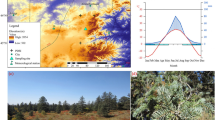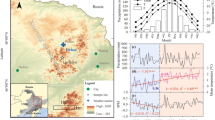Abstract
Spring leaf phenology in temperate climates is intricately related to numerous aspects of the lower atmosphere [e.g., surface energy balance, carbon flux, humidity, the diurnal temperature range (DTR)]. To further develop and improve the accuracy of ecosystem and climate models, additional investigations of the specific nature of the relationships between spring leaf phenology and various ecosystem and climate processes are required in different environments. This study used visual observations of maple leaf phenology, below-canopy light intensities, and micrometeorological data collected during the spring seasons of 2008, 2009, and 2010 to examine the potential influence of leaf phenology on a seasonal transition in the trend of the DTR. The timing of a reversal in the DTR trend occurred near the time when the leaves were unfolding and expanding. The results suggest that the spring decline in the DTR can be attributed primarily to the effect of canopy closure on daily maximum temperature. These findings improve our understanding of the relationship between leaf phenology and the diurnal temperature range in temperate maple forests during the spring. They also demonstrate the necessity of incorporating accurate phenological data into ecosystem and climate models and warrant a careful examination of the extent to which canopy phenology is currently incorporated into existing models.


Similar content being viewed by others
References
Baldocchi DD, Black TA, Curtis PS, Falge E, Fuentes JD, Granier A, Gu L, Knohl A, Pilegaard K, Schmid HP, Valentini R, Wilson K, Wofsy S, Xu L, Yamamoto S (2005) Predicting the onset of net carbon uptake by deciduous forests with soil temperature and climate data: a synthesis of FLUXNET data. Int J Biometeorol 49:377–387
Hadley JL, O’Keefe J, Munger W, Hollinger DY, Richardson AD (2009) Phenology of forest-atmosphere carbon exchange for deciduous and coniferous forests in Southern and Northern New England: variation with latitude and landscape position. In: Noormets A (ed) Phenology of ecosystem processes: applications in global change research. Springer, Dordrecht, pp 119–141
Hanes JM (2011) Multi-scalar analysis of spring phenology in a northern mixed forest. Dissertation. University of Wisconsin-Milwaukee
Hayden BP (1998) Ecosystem feedbacks on climate at the landscape scale. Philos Trans R Soc Lond B 353:5–18
Kucharik CJ, Barford CC, El Maayar M, Wofsy SC, Monson RK, Baldocchi DD (2006) A multiyear evaluation of a Dynamic Global Vegetation Model at three AmeriFlux forest sites: vegetation structure, phenology, soil temperature, and CO2 and H2O vapor exchange. Ecol Model 196:1–31
Leathers DJ, Palecki MA, Robinson DA, Dewey KF (1998) Climatology of the daily temperature range annual cycle in the United States. Clim Res 9:197–211
Liang L (2009) Landscape phenology of Wisconsin’s temperate mixed forest. Dissertation. University of Wisconsin-Milwaukee
Liang L, Schwartz MD (2009) Landscape phenology: an integrative approach to seasonal vegetation dynamics. Landsc Ecol 24:465–472
Liang L, Schwartz MD, Fei S (2011) Validating satellite phenology through intensive ground observation and landscape scaling in a mixed seasonal forest. Remote Sens Environ 115:143–157
Morisette JT, Richardson AD, Knapp AK, Fisher JI, Graham EA, Abatzoglou J, Wilson BE, Breshears DD, Henebry GM, Hanes JM, Liang L (2009) Tracking the rhythm of the seasons in the face of global change: phenological research in the 21st century. Front Ecol Environ 7:253–260
Richardson AD, Hollinger DY, Dail DB, Lee JT, Munger JW, O’Keefe J (2009) Influence of spring phenology on seasonal and annual carbon balance in two contrasting New England forests. Tree Physiol 29:321–331
Richardson AD, Anderson RS, Arain MA, Barr AG, Bohrer G, Chen G, Chen JM, Ciais P, Davis KJ, Desai AR, Dietze MC, Dragoni D, Garrity SR, Gough CM, Grant R, Hollinger DY, Margolis HA, McCaughey H, Migliavacca M, Monson RK, Munger JW, Poulter B, Raczka BM, Ricciuto DM, Sahoo AK, Schaefer K, Tian H, Vargas R, Verbeeck H, Xiao J, Xue Y (2012) Terrestrial biosphere models need better representation of vegetation phenology: results from the North American Carbon Program Site Synthesis. Glob Chang Biol 18:566–584
Schwartz MD (1992) Phenology and springtime surface-layer change. Mon Weather Rev 120:2570–2578
Schwartz MD (1996) Examining the spring discontinuity in diurnal temperature ranges. J Clim 9:803–808
Schwartz MD, Crawford TM (2001) Detecting energy-balance modifications at the onset of spring. Phys Geogr 22:394–409
Schwartz MD, Hanes JM (2010) Intercomparing multiple measures of the onset of spring in eastern North America. Int J Clim 30:1614–1626
Acknowledgments
The data for this study were provided by Dr. Mark D. Schwartz. The data were collected as part of a larger study supported by the National Science Foundation under grant numbers BCS-0649380 and BCS-0703360. I thank Dr. Schwartz and Dr. Keith Henderson for the insightful comments they offered in response to an initial presentation of this research at the annual meeting of the Association of American Geographers in February 2012. I also thank the two anonymous reviewers for their insightful comments that greatly improved the quality of this study.
Author information
Authors and Affiliations
Corresponding author
Rights and permissions
About this article
Cite this article
Hanes, J.M. Spring leaf phenology and the diurnal temperature range in a temperate maple forest. Int J Biometeorol 58, 103–108 (2014). https://doi.org/10.1007/s00484-012-0603-1
Received:
Revised:
Accepted:
Published:
Issue Date:
DOI: https://doi.org/10.1007/s00484-012-0603-1




